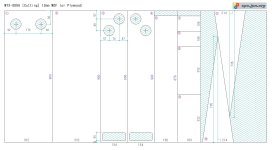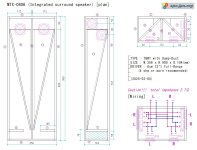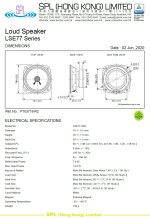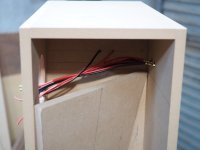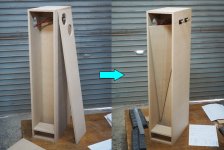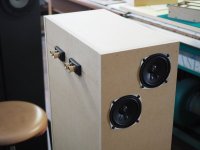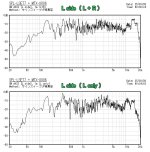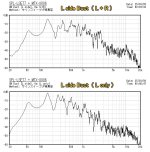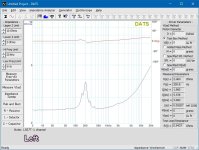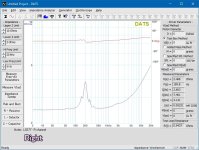I built a front 2-channel surround speaker.
The drivers used are SPL Limited's LSE77-20R (4.5 USD).
Box name is MTX-0806 (TQWT with Damp-Duct).
The front is L+R, the left side is L-R, and the right side is R-L.
The surround effect varies from source to source, but the surround effect is not as good as expected.
I am wondering how to improve the surround effect in the future.


The drivers used are SPL Limited's LSE77-20R (4.5 USD).
Box name is MTX-0806 (TQWT with Damp-Duct).
The front is L+R, the left side is L-R, and the right side is R-L.
The surround effect varies from source to source, but the surround effect is not as good as expected.
I am wondering how to improve the surround effect in the future.
Attachments
Hi tansand.
The 3 and 4 driver systems are an electrical speaker matrix.
MTX-0806 is a “physical speaker matrix” and can be used with Class D and BTL amplifiers.
In the case of mono playback, with an electrical matrix the difference signals (L-R, R-L) become 0, but with a physical matrix all difference signals are output.
I believe that the surround effect is better with an electrical speaker matrix.
The 3 and 4 driver systems are an electrical speaker matrix.
MTX-0806 is a “physical speaker matrix” and can be used with Class D and BTL amplifiers.
In the case of mono playback, with an electrical matrix the difference signals (L-R, R-L) become 0, but with a physical matrix all difference signals are output.
I believe that the surround effect is better with an electrical speaker matrix.
It seems that reproducing the inverse phase component in the same box will depress the low frequencies.
It seems to be a good idea to separate the difference signals in the box.
And, caution is required as the impedance is low.

It seems to be a good idea to separate the difference signals in the box.
And, caution is required as the impedance is low.
Attachments
I air-recorded a music source with a good surround sound feel.
[Air-Recording] So Nice / Stacey Kent
[Air-Recording] Three Seconds / Michael Naura
[Air-Recording] Belkis, Queen of Sheba / Eiji Oue
[Air-Recording] So Nice / Stacey Kent
[Air-Recording] Three Seconds / Michael Naura
[Air-Recording] Belkis, Queen of Sheba / Eiji Oue
I was recently reading through some old threads regarding using three (identical) loudspeakers for stereo listening. The most heated debate was already years ago.
I would be really glad to hear from everyone, who is using a three loudspeaker setup for stereo.
My own experiment with the Single Speaker Stereo (three fullrangers matrixed in a single box) were quite encouraging and I would like to experiment a bit more - especially with extended bass and more SPL - I will share my experiments as they will come.
I am especially interested in configurations where the speakers are relatively...
I would be really glad to hear from everyone, who is using a three loudspeaker setup for stereo.
My own experiment with the Single Speaker Stereo (three fullrangers matrixed in a single box) were quite encouraging and I would like to experiment a bit more - especially with extended bass and more SPL - I will share my experiments as they will come.
I am especially interested in configurations where the speakers are relatively...
It is a stereo field.the left side is L-R, and the right side is R-L.
So the left would be left only , and the right would be right only.
These speakers are essentially 90 degrees off axis, so treble roll off would be as shown like any speaker 90 degrees.
Sound being directional anyways, off axis only 450 Hz on down would actually be audible. Or start becoming omni at 450 Hz
and be fully omni at 250 Hz down. Humans can still slightly tell direction at 450 Hz from additional brain function, not with ears.
To have rear speakers they would be mounted in the .....rear.
And only useful for movies or soundtracks were producer has placed actual tracks or sounds in the rear intentionally.
Normal " rear" speakers would be 180 degrees. Indicating the direction the emulated sound would be coming from.
For a " wide" stereo image, you just use normal 2 channel stereo, with the speakers set wide or far apart.
The so called "image" sounding "forward" or " rearward" is in the original recording.
If you want the image to move forward or rearward from the original recording.
Just flip the right / left.
Last edited:
There's a good collection of information in this post.I was recently reading through some old threads regarding using three (identical) loudspeakers for stereo listening. The most heated debate was already years ago.
I would be really glad to hear from everyone, who is using a three loudspeaker setup for stereo.
My own experiment with the Single Speaker Stereo (three fullrangers matrixed in a single box) were quite encouraging and I would like to experiment a bit more - especially with extended bass and more SPL - I will share my experiments as they will come.
I am especially interested in configurations where the speakers are relatively...
Hi Karlsonate.
The URL you refer to is an electrical matrix with three drivers, so it is fundamentally different from the physical matrix presented in this thread.
It is a stereo field.
So the left would be left only , and the right would be right only.
Thanks, I had missed this 2023 thread. Not sure if @ASCTim has somewhat changed his assessment; there were multiple threads on related subjects (such as his "A Hafler inspired solution for the phantom center image problem"). All rather confusing to me! Good to see his (2023 above) chart that higher frequency lost stereo separation in "differential" L-R | L+R | R-L, which made perfect sense and matched what I heard.There's a good collection of information in this post.
This below, "wall-bounce dipole-differential with omni-center console", using four drivers, two amps and normal wiring, might be closer in spirit to @nandappe's?
I combined up-firing omni with side-firing differential dipoles to get a "wall-bounce stereo console" using two integrated amps and two pairs of drivers -- no fancy hookup or electronics, in fact crossover-less. The split formula is (L+R)+f(L-R) | L+R | (L+R)-f(L-R).
https://www.diyaudio.com/community/...from-a-single-loudspeaker.200040/post-7681161


https://www.diyaudio.com/community/...from-a-single-loudspeaker.200040/post-7681161
Last edited:
I changed the physical matrix wiring to a normal 2-channel wiring(3 parallel).
I thought the stereo feel would be worse, but due to the high sound pressure on the sides, the stereo feel is greater than the box size.
Bass has also improved.
I will be demonstrating this speaker at a presentation with my audio friends on April 27.



I thought the stereo feel would be worse, but due to the high sound pressure on the sides, the stereo feel is greater than the box size.
Bass has also improved.
I will be demonstrating this speaker at a presentation with my audio friends on April 27.
Of course. The whole system is equivalent to 2 drivers (front) in the box, low-frequency wise.It seems that reproducing the inverse phase component in the same box will depress the low frequencies.
Loudspeaker box should be optimally designed for a fixed number of drivers only. For how much drivers is this box designed?
I changed the physical matrix wiring to a normal 2-channel wiring(3 parallel).
I thought the stereo feel would be worse, but due to the high sound pressure on the sides, the stereo feel is greater than the box size.
Bass has also improved.
I will be demonstrating this speaker at a presentation with my audio friends on April 27.
View attachment 1439811
View attachment 1439812
View attachment 1439813
I think this makes sense. You are now getting pure 2L bounce off the left wall etc., rather than a phase-randomized admixture with -R.
Short conclusion is that differential (L-R, 2L-R etc.) in principle reduces stereo separation at high frequency producing enhanced mono; then tricks are needed to recover stereo effect.
I would be even more intrigued to see your 3-driver bipole firing orthogonally front/side/upward. Maybe you can test that by placing a small wing to bounce one of the side drivers upward toward the ceiling.
Last edited:
Bandwidth limited [ filtered ] drive to out-of-phase drivers can create quite impressive results + a reduction of 'inner box cancellation'.
https://www.google.com/search?q=ste...MuMTegB86YAbIHBjAuMy4xN7gHnSQ&sclient=gws-wiz
https://www.google.com/search?q=ste...MuMTegB86YAbIHBjAuMy4xN7gHnSQ&sclient=gws-wiz
I played it with a Bluetooth amplifier base and a mobile battery.

[Air-Recording] Better Be Home Soon / Andrea Zonn
[Air-Recording] Belkis, Queen of Sheba / Eiji Oue
[Air-Recording] Take Five / Helge Lien
[Air-Recording] Better Be Home Soon / Andrea Zonn
[Air-Recording] Belkis, Queen of Sheba / Eiji Oue
[Air-Recording] Take Five / Helge Lien
Last edited:
Of course. The whole system is equivalent to 2 drivers (front) in the box, low-frequency wise.
Loudspeaker box should be optimally designed for a fixed number of drivers only. For how much drivers is this box designed?
Hi Sonce.
My favorite way to have fun is to make boxes as I think of them and attach various drivers to them.
I don't have the skills to design and build a box specifically for a specific driver.
- Home
- Loudspeakers
- Full Range
- Integrated 2ch sound field creation speaker (3" Full-Range x 6 pieces)
